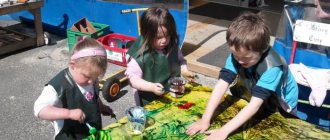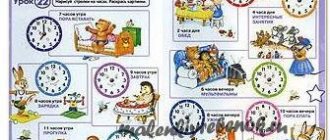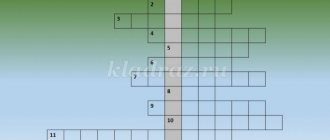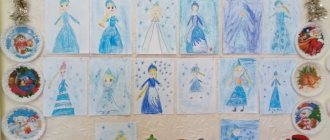Preview:
Construction game: “We are building a city and a village.”
Tasks:
To promote the improvement of skills in constructive activities,
Formulate a self-assessment of the final result,
Contribute to the creation of a positive emotional atmosphere,
Promote the development of coherent speech,
Carry out construction in a certain sequence,
Nurture collective relationships in the process of constructive activities.
instill patriotic feelings;
Equipment: building diagrams, attributes for construction.
Preliminary work: individual, subgroup, frontal work on the design of various buildings, construction of a city, village; familiarization with elementary mathematical concepts.
Sources: Program and technology “Kindergarten - a house of joy” by N.M. Krylova.
Progress of the lesson.
Round dance game "Cubs are playing ball."
V: Let's say hello
Motivation.
Q: Who do you think came first today?
Q: First... you came first today... Will this (doubt) be accurate? (I came first, there was no one else)
V.: It seems to me that you are second. (No, the first of the children)
V.: Why did I say that you are second?! (you can say this because you came first, and I came second)
V.: This is an inaccurate answer... In mathematics it is not allowed to count like this, the counting is inaccurate... When it can be said about us that there are TWO of us... or TWO (two people)
V.: So who is first today? (both you and me). The answer reflects an understanding of the problem.
V.: Today you and I can both call ourselves “first”... Only you will be the first... who? (Child) Yes, I will be the first (adult). And if I say that I am the first MAN, then you will?! (Second person - sounds like eureka, joyful).
V.: Go to the calendar and see if FIRST is there. (Today is December 1; December is the first month of winter, Monday is the first day of the week, January will be the first month of the year).
Q: What are the names of children who come to kindergarten? (Preschoolers)
Q: What will they call you when you go to school? (Pupils)
V.: There is this type of work - construction. What professions are people called builders? (called).
V.: Do we have building material... Can we be builders?! (Can )
Q: Where do you want to build? What material…? What are you planning? So, what happens (strangely) that every builder builds wherever he wants?! (Children must understand that a builder, like any other profession, depends on the plans of the architect, and their plans depend on the conditions of the area).
Q: Have you chosen WHAT you want to build? And who was missing so that your results of labor... and bridges, and houses, and roads, and factories would benefit people and be convenient for them?! (You need an architect..., he plans a city or a village...).
Q: But before building, what should he do? Choose a location. So, the main FIRST in construction will be the architect?!
V.: Well, in order for all the buildings and structures to be distributed, the architect needs to draw everything on the board.
V.: So, who were we yesterday? (architects)
Q: What professions of builders will we have? (Bridge builders, road builders, house builders... And we also need to build a station... And a factory... We will build a village... And we will build a dairy plant in the city).
Q:Can you come up with a game about what is drawn on the board?
V.: So, what are we up to today? (build a city and a village)
V.: Can you build it so that everyone can live comfortably, so that
the buildings were STRONG, WARM, SO THAT IT WAS COMFORTABLE... (excitingly)? (Yes ).
V.: You agree too quickly (jokingly), but can you (excitingly) build such a city?! (Can ).
V.: Probably, we need to think not only about how beautiful the city and village will be, but also where we will place them.?!
V.: Well (thinking) you can build according to the plan, like, for example, St. Petersburg was built... Or you can build it like Moscow was built... It wasn’t built all at once, but gradually... There was no plan for the layout of the streets in advance, they built around the Kremlin .
Q: How did you and I decide to build? (According to plan).
V.: In our city there is a main square, from it there is a main street. There is an entrance and a train station. Will there be a river? This is the river...
Q: YOU are architects and builders, you have individual projects, please choose.
V.: And I say: “The city will be founded here, according to this plan.”
Activity.
Grade. Built.
V.: Construction time has expired. Let's discuss the development of the city and countryside? You probably agree that it’s good for the city and village to be beautiful, comfortable, and, of course, for the buildings to be durable? (Yes)
Everyone gathered for the assessment.
Q: What country do we live in? (Russia)
Q: What are those who live in Russia called? (Russians)
Q: What city do we live in? (Kemerovo)
Q: What is the name of the city that you built? (Suggest titles)
Q: The city that you built is in what country? (In Russia )
V.: Excuse me, how to determine this? (There is a flag on the main building of the city)
Q: What else can be a symbol of the state? (Coat of arms, anthem)
(Play Russian anthem)
Q: Is it convenient for residents to live in your city? Why? (Explain).
V.: Well, so your residents only relax, but they have nowhere to work?!
Are everyone unemployed? (There is a plant).
V.: Well, if there is a plant, then, probably, someone works at the plant, which means there is a result of the work?! (They will begin to fantasize about what they produced at the factory).
Q: Where do the raw materials for the plant come from? (
Q: Where are the products sent and to whom?! Should I send it far or close?! (They reason).
Q: How should it be sent..., what transport...? It is possible, of course, by river transport, but also by rail. ., maybe by plane...?! (They argue, if they call it river transport)
Q: Do you have piers? (No, but then you can by plane).
Q: Is there an airfield? (They reason).
Q: You had everything in the stores... both vegetables and fruits? (Yes).
V.: And they just lie in the store... and don’t run out?! (They are transported). On what?
Q: Where are they unloaded? (Future buildings are called again).
V.: They took it out... and they will bring it to you... From where? (Showing village houses)
Q: Did you bring anything from there? (Called)
Q: What could be sent there from your city?
(Yes, they probably need both scythes and tractors...).
V.: Well done! You are real builders!
Those who complete the conversation either play in the built city or look at books. But most will strive to play. It will take the form of a director's play. Children will talk about nesting dolls (of different sizes), take them to shops, theaters, schools, etc. Obviously, children will be happy to play with city buildings, roads, take nesting dolls to the theater, to the store...
APPLICATION
- an important component in the upbringing and education of children. Therefore, first you need to consider some questions about constructive ones. I hope that the material I told will help you in teaching children.
What questions will we consider:
- What are constructive
- What does a child need for constructive play?
- Stages of development of constructive play
- Techniques for teaching constructive play
What it is? - this is a type where children reflect their impressions of surrounding objects, independently make various buildings, structures, buildings, roads, but do it in a schematic, generalized form. In constructive games, objects are replaced by other objects, that is, buildings are erected from special construction sets, building kits, and natural materials. That is why constructive games are classified as creative games. For children 3-5 years old, constructive games often take the form of role-playing games, in which children play the role of construction workers.
What does a child need for constructive play?
- The ability to create an image of an object in its spatial expression. This is how a sense of orientation in space develops, the ability to distinguish and establish the proportions and size of an object, its spatial relationships.
- The ability to evaluate and take into account the properties and quality of the materials used during construction, to anticipate and carry out a sequence of actions. Therefore, constructive games teach children to set goals and plan their actions.
- Constructive games develop in children the ability to compare and contrast the structure they created with the real objects on the basis of which the structure was built. This develops observation and attentiveness in children.
Stages of development of constructive play
- Children 3-5 years old depict single objects and small structures. The themes of their buildings are related to their role-playing games, for example, a garage for a car, a house for a doll. Their designs are very simple. Their buildings are arranged horizontally, like a drawing on paper. The same house for a doll is a certain space that is fenced off with several cubes, and on top there is some kind of plate or plank called a roof. Children at this age erect a building, then destroy it and begin to build it again. They are interested in the construction process itself, and not in the result obtained at the end of this activity. It often happens that construction is ahead of the plan: the child begins to build something, and only then recognizes some object in his construction.
- Children aged 5-7 years gradually expand the themes of buildings. They have ships, roads, bridges, buildings, cars. In their designs, children try to convey the originality of a particular structure. For example, they are building not just a house, but their own house in which they live or their own kindergarten. At this age they begin to complicate the structure itself. The buildings are growing upward. Children decorate them with columns, towers, windows, using various ceilings.
Techniques for teaching constructive play
Adults (parents and kindergarten teachers) should teach children constructive skills and abilities. Because without this, children's buildings will remain simple and primitive. There are several ways adults can teach children the skills needed for constructive play.
- Examination of objects, structures, buildings. During examination, it is necessary to draw children's attention to the purpose of the object, the features of its design, parts and their proportions. All this should be accompanied by a conversation with the children (namely a conversation, not a monologue by an adult). You can also additionally consider drawings of similar objects.
- The indirect guidance of an adult is the enrichment and updating of children’s knowledge about the objects and characteristics of the materials from which they build their buildings.
- Direct guidance is the role-playing participation of an adult in the game, explanations, and advice during the game.
Today we talked about constructive games
, about the skills that a child needs for them, about the stages of constructive development and about techniques for managing them.
If you have any additions on this issue, be sure to leave your comment.
More from my site
Date of observation: 04/24/2014
Summary of a design lesson in the middle group “Fences and Fences”
Fences and fences
…
Target. Exercise children in closing space by arranging planar figures; in distinguishing and naming the four primary colors (red, blue, yellow, green) and geometric shapes (square, triangle, circle, rectangle); consolidate ideas about the main construction parts and parts of the designer (cube, brick, block); teach to understand an adult, think, find your own solutions.
Material. A cube (a red cube from a building set, on one side of which eyes and a mouth are glued), a box with building material, an envelope, paper plane models of various shapes, pencils, felt-tip pens.
Progress
Get your children interested in a fairy-tale plot, set them up emotionally, and try to create an expectation of the unusual, magical, and mysterious. Introduce them to the Cube. Chat with them on behalf of Kubik, invite the guys to visit him in the magical country of Formandia, where you can only get by completing tasks. Ask a riddle:
I have a box, my friends live in it. They are very different, Yellow, red, Green and blue, All friendly and strong. They love to gather together and turn into buildings. (Box with cubes, construction set)
Working with the illustration “Door to Formandia”.
Draw the children's attention to the picture (Fig. 1) and tell them that it shows a door to the country of Formandia. Offer to find the keys to the door at the bottom of the sheet (square, round, triangular and rectangular), cut off the strip on which they are depicted, cut it along the lines into pieces and cut out the shapes.
Invite the children to “open” the door to Formandia with keys, placing them on appropriately shaped locks. Praise them for completing the task correctly, ask them to collect the keys and put them in an envelope.
On behalf of Kubik, invite the guys to a magical land.
Working with illustrations “Let’s go for a visit.”
Invite each child to choose one of the proposed pictures (Fig. 2, 3, 4, 5).
Talk with the children about the content of the pictures: “Who did we come to visit? What is shown in the pictures? Why does the bunny need so many apples? What color are apples? How many apples does a bunny carry in a car? What is the cat doing? And so on".
Rice. 1
Rice. 2
Rice. 3
Rice. 4
Rice. 5
Invite the children to color the pictures. Find out what color and what they paint. Advise to color small parts with felt-tip pens, and large parts with pencils.
While working, read poems to the children that correspond to the content of the pictures:
The bunny's apples are ripe in the garden. Red lanterns burned on the branches. Look at the cat, at the cat, at the painter, the cat paints and sings, invites us to visit him: “Pur, pur!” Petya, Petya, cockerel, Petya - a ringing voice. Petya is strict, Petya is important, Petya is strong and brave. Here is a green friend - a bug-eyed frog, sitting by the pond in the morning and looking at the float.
Invite the children to look at the colored pictures and identify what is in all four pictures. (Fences.)
Let the children carefully examine the fences.
Working with the illustration “Fence with a patterned lattice.”
Invite the children to look at the illustration (Fig. 6) and think about the question: “What could be behind this fence?” and build beautiful fences from building material. Teach them to build several options for fences on the table from any parts of 2-3 types and colors.
Look at the fences with your children, highlight familiar details. Let them choose any toys and build fences, fences, fences for them (a sand yard for dolls, a pool for swimmers, a pond for ducks, a corral for horses, etc.). The children choose the shape of the fence themselves (take sheets of colored paper in round, square, rectangular, triangular shapes, place them on the table and begin to build them).
At the end of the work, admire the buildings with the children, consider how different the fences turned out, what color and shape they consist of.
Then offer the children a construction set, for example, Lego Duplo bricks. Let the children invent and build any kind of fences from them. As you work, ask them how regular building parts differ from Lego Duplo parts and how Lego Duplo parts are held together.
Game tasks.
Construction of fences, aquariums, lakes, flower beds, parking lots, etc. Construction of fences with and without support models, showing construction methods (indicative parts are installed at the four corners, then the distance between them is built).
Rice. 6
Tips for a teacher
Encourage children to independently analyze buildings; teach to talk about what parts are made of and how they are built; encourage a harmonious combination of details in shape and color, independence, and contact with peers and adults. Help develop game stories; offer to carefully dismantle buildings and structures, lay out parts, and put them back in place.
Keep a notebook for notes (conclusions about the activities of the children, their successes, failures, questions; records of children's words, original, unusual judgments, funny remarks, extraordinary manifestations).
Keywords
Square, triangle, circle, rectangle, cube, brick, block.
PLAN FOR A GAME WITH BUILDING MATERIAL “FARM”
OUTLINE OF THE GAME WITH BUILDING MATERIAL:
Group
III mixed age
Subject
"Farm"
Type of design:
design on a given topic
Teacher Mikheeva Anna Vladimirovna
Tasks:
- educational: Teach independently, select the necessary parts in accordance with the nature of the building and carry out the construction according to the teacher’s model.
— developing: developing in children the ability to use construction table material and act with it in a variety of ways.
- educational: Develop friendly relationships in the game
Methods and techniques for managing gaming activities:
- verbal: vocabulary work
— visual: building material
— practical: playing with the building
Playing materials and equipment:
Teacher
For each child
Are common
Tabletop building material (bars, cubes, arches), set of Farm toys.
Tabletop building material (bars, cubes, arches), set of Farm toys.
Tabletop building material (bars, cubes, arches), set of Farm toys.
If, during the course of the lesson, children will move around the group room, it is advisable to draw a plan for the placement of the necessary play equipment.
Preliminary work:
Conversation about pets
Individual work
: Playing with different toys representing pets and babies. What animals are called domestic? Why? Who saw a cow, horse and other animals in the village? What are the names of their cubs?
Progress of the game (tactics of game interaction with children):
Start of the game (introduction to the game situation)
Introduction to game rules and actions
Game problem situations for game development.
Completing the game (reflection)
The teacher gives the children a set of Farm toys and invites them to play.
Draws attention to the fact that the animals need to be provided with a safe place so that they do not run away and no one harms them, leading the children to the conclusion that it is necessary to build a fence around the farm.
The teacher suggests populating the farm with small animals (piglets, sheep, poultry) and checking whether the fence is high enough. Then large animals (cows, horses) move in.
The teacher shows a sample of a fence superstructure (the cube alternates with an inverted arch, placed close to each other on top of a fence made of bars).
The teacher asks questions about the farm and offers to play with the building.
Children looking at a set of toys
Children themselves choose the building material (bars) and build a fence by placing parts close to each other.
Children come to the conclusion that the fence is not high enough
Children finish construction
Playing "Farm"
The children became interested in the game and listened with pleasure to the teacher
Children build their own fence
The game continues by fixing the fence
The children learned how to build a fence for animals. Play around the building
Analysis of the game with building materials
Analysis of observation of children's play activities and the role of the teacher
- Compliance of the tasks with the age characteristics of the children.
- What preparatory work was carried out before the game, was it expedient?
- What building material was used in the game (specially created, natural, auxiliary).
- Methods and techniques of stimulation and motivation to play.
- The effectiveness of methodological techniques used during the game and for its completion.
- What type of construction was used during the game, its age-appropriateness, feasibility:
- on a given topic;
- by design;
- according to the conditions;
- "according to models".
- Place and time for the game.
- Children's associations.
- What conditions were created to play around with the buildings?
- Educational orientation of the game.
Analysis of construction game management techniques used by the teacher.
1. Did the game bring joy to the children?
2. Reasons for the achieved result - preparation for the game:
— planning the game (does the program content correspond to the age and level of development of children, is the complex management of the game reflected in the program content;
— creation of conditions (what time is allocated in the daily routine, is there a special place in the group, how is the game equipped);
— preparation of children;
— on whose initiative the game arose;
— whether there was a preparatory period of play in accordance with age;
— are children independent during play or does the game develop with the participation of the teacher;
- what was the guidance of the game on the part of the teacher (techniques, directions);
— did the teacher suppress the children with his interference?
- children’s activities in play;
— how the task of developing creativity, initiative, and imagination in children was solved;
- how the game was completed - organized or unexpected;
— how the analysis was carried out.
3. How would you direct this game?






